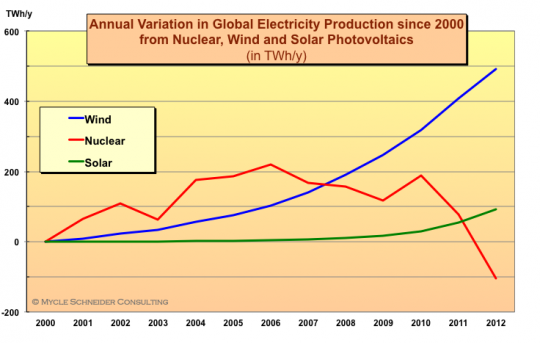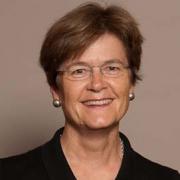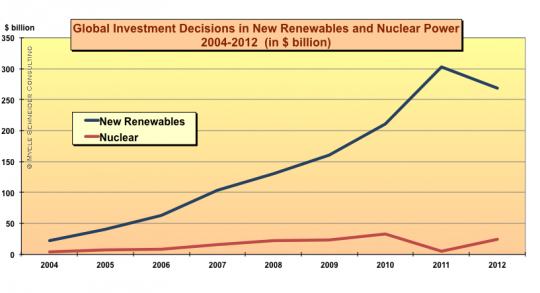Yesterday was a telling day to contemplate the future of nuclear power, renewables, and the future of energy generally, as I did while moderating an excellent webinar on nuclear power and climate change for some key NIRS supporters, featuring Dr. Arjun Makhijani of the Institute for Energy and Environmental Research, Mark Cooper of the Vermont Law School’s Institute for Energy and the Environment, and Tim Judson, Acting Executive Director of NIRS. An edited, digestible version of the two-hour event will be available on NIRS website as soon as we can do the editing…
The webinar offered convincing and well-documented assertions that a) nuclear power cannot possibly be a useful means of addressing climate change; indeed, it only makes the problem worse; b) in fact, the entire antiquated concept of “baseload” power makes the problem still worse by preventing the full implementation of 21st century energy technologies; c) even if nuclear power–including existing reactors–were able to address climate, it would be too expensive to do so and that expense crowds out better alternatives; and d) the nuclear industry’s efforts to save its existing reactors (forget about building new ones) is beginning to look like an all-out war on renewables and ratepayers alike.
But the webinar isn’t really the point of this piece, it’s that yesterday provided a tell-tale snapshot of where the nuclear industry is, where it’s headed, and what obstacles are likely to be thrown in front of the path to a nuclear-free, carbon-free energy future.

In the morning, the nuclear and fossil-fuel funded Center for Climate and Energy Solutions (known in Washington as C2ES) held a seminar at the National Press Club featuring Nuclear Matters’ latest spokesperson Carol Browner; representatives from Areva, Exelon and Entergy; DOE’s Assistant Secretary for Nuclear Energy Pete Lyons; Sue Tierney who headed President Obama’s Energy Department transition team and is now at The Analysis Group; and C2ES President Eileen Claussen, a long-time advocate of using nuclear power as a climate change strategy. The purpose of the event was release of a new paper from C2ES, which is almost remarkable in its agreement with the arguments being touted by Nuclear Matters. Those arguments boil down to: nuclear reactors are in trouble economically, let’s do whatever we can and make any silly case we can to keep them running no matter how much it increases ratepayers’ bills. Oh, and baseload power. Did we mention baseload power? Don’t forget baseload power.
Given that line-up, who could have expected anything else? As we’ve said before, the nuclear power industry is getting desperate, and that desperation is increasingly visible.
That desperation, of course, is based on the shutdowns and planned shutdown of five operating reactors over the past year and the industry’s realization that this is just the beginning. Instead of a growing industry fueled by a now non-existent nuclear “renaissance,” the industry faces the prospect of more shutdowns and a rapid decline that seemed unthinkable just five years ago.
Still, one useful bit of information emerged from the seminar. Both Claussen and Tierney pointed to State Implementation Plans for the Clean Air Act that will be filed by states with the EPA over the next five years as a leverage point to rig the scales in favor of nuclear power. This will be an arena clean energy activists will have to focus on and participate in.

But it wasn’t all happy talk for the industry even at the C2ES seminar. Tierney (who, in fairness, was very accommodating to clean energy groups during the transition period, much more so than DOE has been since), for example, threw cold water on the idea of new nuclear reactors, “You’re not going to see it happen in an unregulated environment, period,” she told reporters after the event. “They’re too expensive compared to the alternatives and I don’t think you’ll see a merchant new nuclear plant in the United States, especially with low gas prices.”
Even while the C2ES seminar was going on, the Energy Information Administration (EIA) was confirming the industry’s fears. The EIA issued its 2014 annual report projecting that another 6,000 MW of nuclear power–or six more large reactors–is likely to permanently shut down by 2020. That’s in sharp contrast to last year’s EIA report–issued before last year’s shutdowns, which projected only 7,700 MW of reactor shutdowns by 2040. Adding in those shutdowns already announced, and EIA’s projection comes to nearly 11,000 MW of planned and projected shutdowns by 2020.
In our view, even EIA’s projections are unduly conservative.
Those are the same words used by Sun Day Campaign director Ken Bossong about EIA’s projections for renewable energy growth. In its new report, EIA projects renewables under different scenarios to account for anywhere from 16% to 27% of U.S. electricity by 2040. As we reported last Wednesday, the 16% projection simply doesn’t make sense–renewable energy growth would have to slow dramatically, which absolutely no one projects, to be at such a low level in 2040. As Bossong said then, “We believe this projection does not pass the laugh test.” But even the higher 27% projection–though new for EIA–is far lower than seems even possible, much less likely.

A Sun Day Campaign press release issued today points out: “In fact, based on the actual growth rates for renewable energy sources (i.e., biomass, geothermal, hydropower, solar, wind) over the past decade, multiple other studies, and even analyses from EIA itself, it is likely that renewables will comprise a much larger share of the nation’s electrical generating supply by 2040 — perhaps two, three or more times higher than the Reference case level forecast by EIA.”
As Bossong points out, the forecasts matter: “Unrealistically low forecasts provide ammunition for those arguing that investments in renewable energy are not cost-effective and that new fossil fuel and nuclear construction is necessary because renewables cannot meet the nation’s future energy needs. As such, EIA’s projections can have multiple adverse impacts on the renewable energy industry as well as on the nation’s environmental and energy future.”
Some initial media accounts of the EIA report focused on the possibility that accelerated reactor closings would lead to the U.S. being unable to meet its carbon emissions goals–exactly the message that Nuclear Matters and C2ES wanted. But that would only be the case if reactor shutdowns were replaced entirely by fossil fuels, most likely natural gas. In fact, as EIA pointed out, coal plant closings are likely to accelerate as well, substantially reducing carbon emissions. But if, as clean energy advocates espouse, reactor shutdowns are replaced by renewables and energy efficiency programs, overall carbon emissions would decline even further. And, if we can get beyond the obsolete “baseload” power notion pressed by C2ES and its nuclear backers, which they know benefits only nuclear and coal, then renewables, efficiency and 21st century grid improvements are exactly what will replace those reactors.
Michael Mariotte
April 29, 2014
Permalink: https://www.nirs.org/2014/04/29/nuclear-boosters-scramble/
You can now support GreenWorld with your tax-deductible contribution on our new donation page here. We gratefully appreciate every donation of any size–your support is what makes our work possible.
Comments are welcome on all GreenWorld posts! Say your piece above. Start a discussion. Don’t be shy; this blog is for you.
If you like GreenWorld, you can help us reach more people. Just use the icons below to “like” our posts and to share them on the various social networking sites you use. And if you don’t like GreenWorld, please let us know that too. Send an e-mail with your comments/complaints/compliments to nirs@nirs.org. Thank you!
Note: If you’d like to receive GreenWorld via e-mail daily, send your name and e-mail address to nirs@nirs.org and we’ll send you an invitation. Note that the invitation will come from a GreenWorld@wordpress.com address and not a nirs.org address, so watch for it.




Please contact me when the edited version of the webinar is published. Also, please do a better job of publicizing such events.
We will post the webinar on NIRS website (www.nirs.org) when editing is complete and will link it from GreenWorld as well. The webinar was not publicized; it was invitation-only, primarily for NIRS funders.